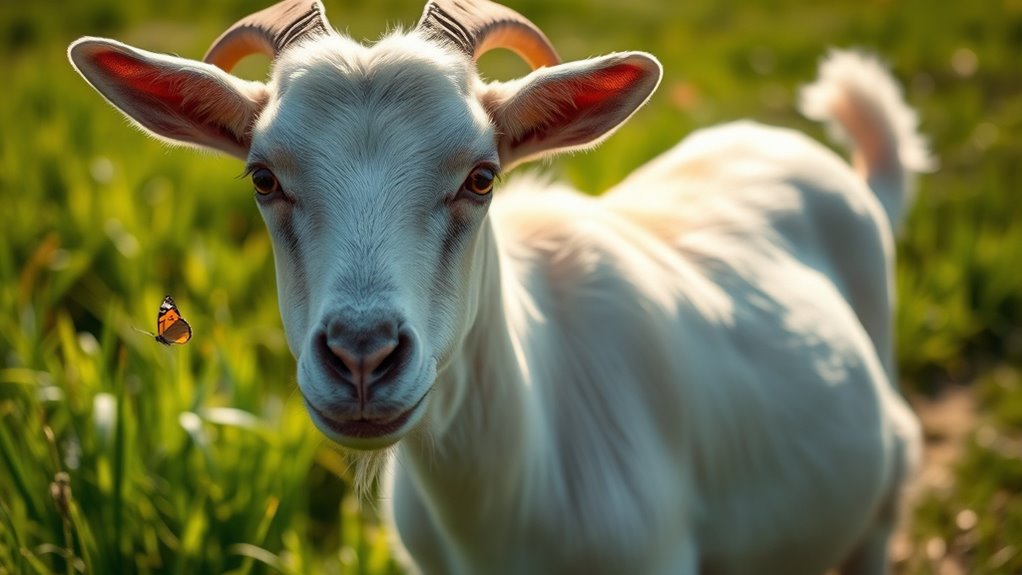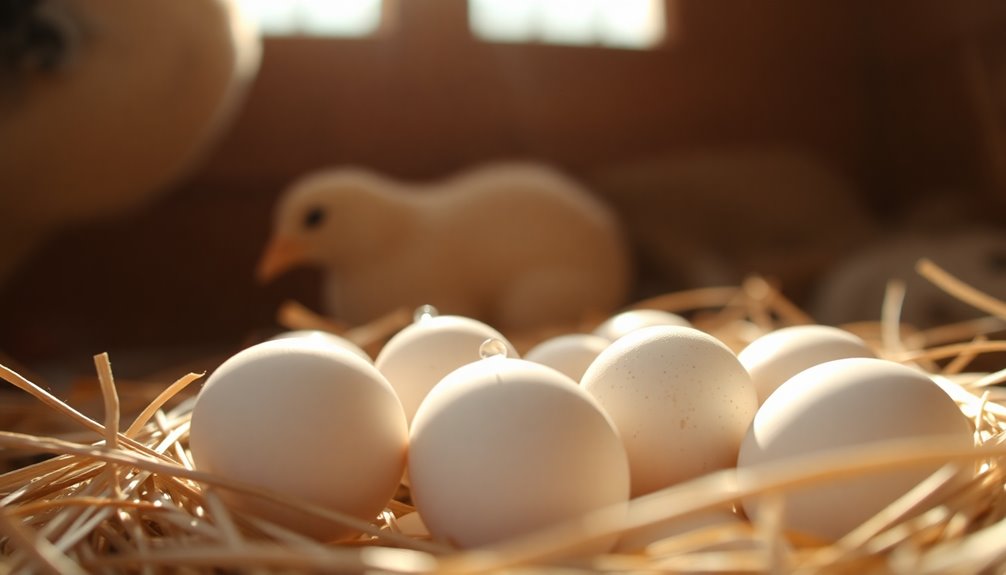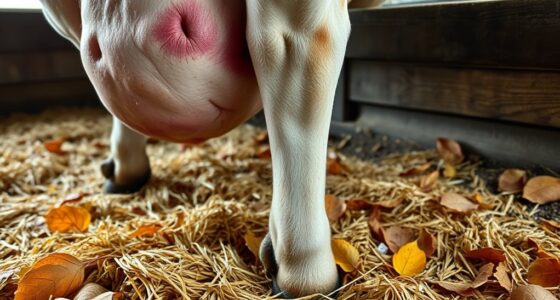To tell if your goat is pregnant, you can use a few simple checks. Look for behavioral changes like increased appetite and restlessness. You may also notice physical signs like udder development and weight gain. For more accurate confirmation, consider ultrasound or blood testing. Both methods provide reliable results. Regular checks help you monitor your goat's health and ensure a successful pregnancy. Discover more methods and tips to simplify your pregnancy checks along the way.
Key Takeaways
- Observe physical signs like udder development, belly tightness, and weight gain to identify potential pregnancy in goats.
- Monitor behavioral changes such as increased appetite, rest, and sociability shifts that may indicate pregnancy.
- Utilize blood testing to detect Pregnancy-Specific Protein B (PSPB) for reliable pregnancy confirmation after 30 days post-breeding.
- Conduct transrectal or transabdominal ultrasounds for early pregnancy detection and fetal monitoring, especially after 20 days.
- Track the goat's behavioral patterns and look for significant changes to accurately assess possible pregnancy status.
Ultrasound Confirmation
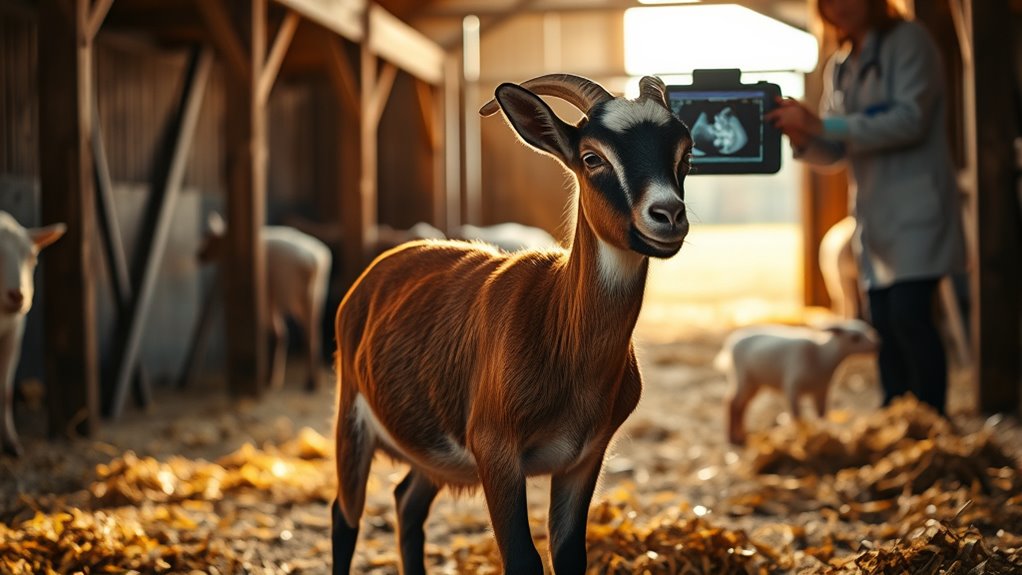
When you want to confirm if your goat is pregnant, ultrasound techniques are among the most reliable methods available.
Transrectal ultrasound can detect pregnancy as early as 20 days, while transabdominal ultrasound starts at 30 days, becoming most accurate after 45 days.
Using real-time B-mode ultrasonography, you can monitor embryonic growth and assess fetal viability by detecting heartbeats typically around 20 days post-mating.
Ultrasound also allows you to accurately determine fetal numbers up to 85 days gestation, which is crucial for managing pregnancy toxemia risks.
This non-invasive method causes minimal stress to your goat and is more cost-effective than radiography.
Monthly scans can further help you track the pregnancy progression, ensuring you stay informed and prepared.
Blood Testing for Pregnancy
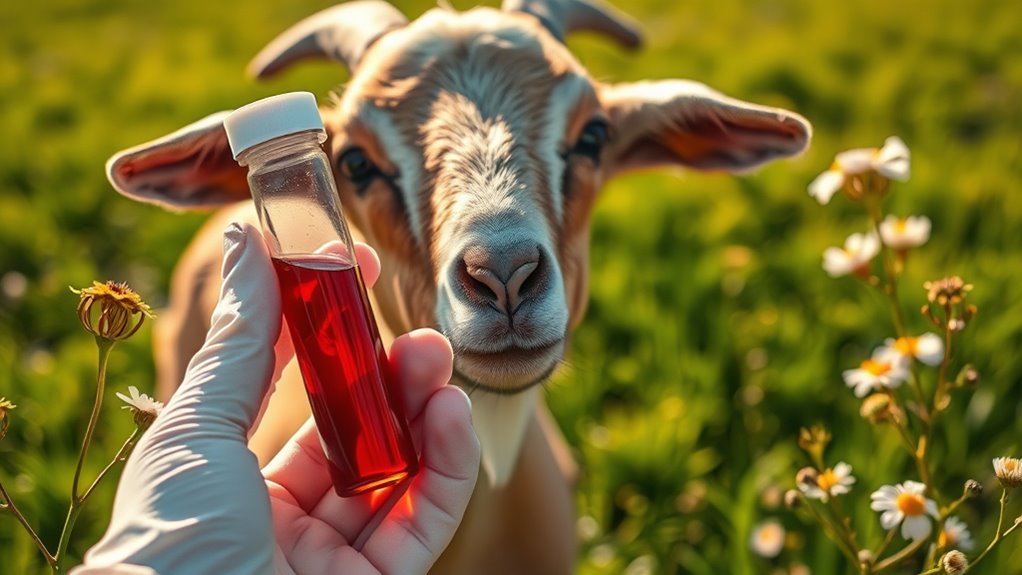
Blood testing offers a reliable way to determine if your goat is pregnant, with accurate results available at least 30 days after breeding.
You'll typically collect a blood sample from the jugular vein using a syringe and vacutainer. The BioPRYN assay is a common test that detects Pregnancy-Specific Protein B (PSPB), produced by the placenta of a developing fetus.
Collect a blood sample from the jugular vein to test for Pregnancy-Specific Protein B using the BioPRYN assay.
This method is cost-effective, averaging around $6 per animal, and tests can be run regularly, providing results shortly after submission.
While blood tests are generally accurate, keep in mind they may not always distinguish between true and false pregnancies.
Utilizing this method allows for early detection, aiding in your herd's reproductive planning and management.
Observing Behavioral Changes
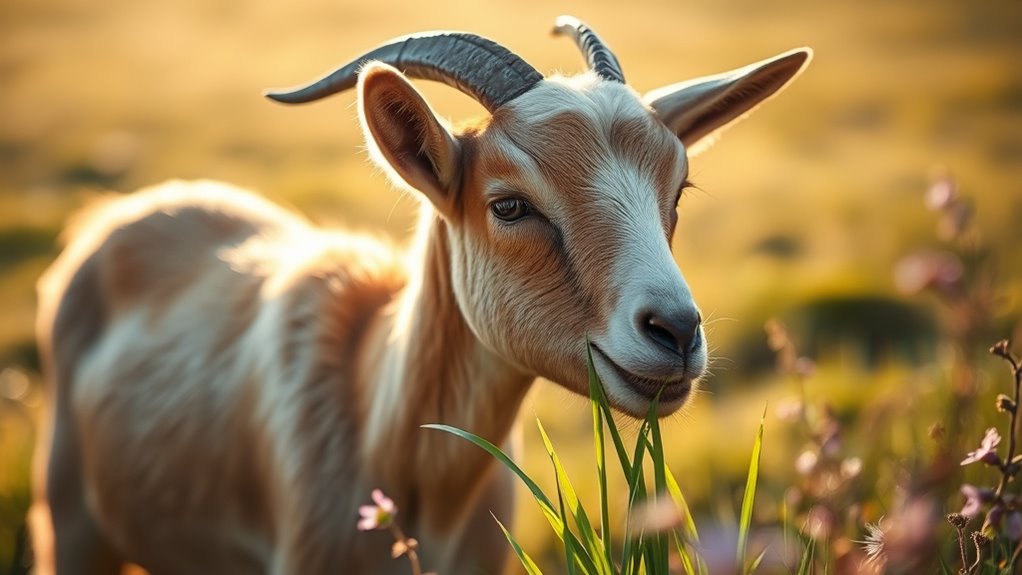
Observing behavioral changes in your goat can provide valuable insights into whether she's pregnant. You might notice an increased appetite, as pregnant goats often eat more to support their developing kids.
Keep an eye on her social behavior; hormonal shifts can make her more or less sociable. If she interacts with bucks, be cautious—they may become aggressive toward her.
Additionally, pay attention to her resting patterns; pregnant goats usually need more rest due to higher energy demands.
You could also see shifts in her personality—normally friendly does might seem standoffish, while shy ones might become more outgoing.
These changes are temporary, so be sure to track her usual behavior for accurate observations.
Noticing Physical Signs
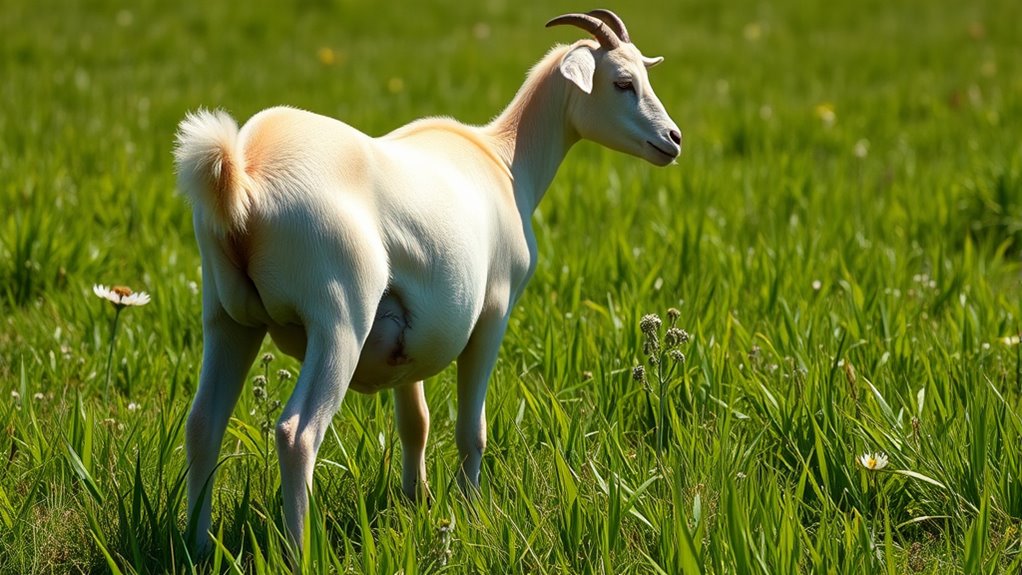
As you monitor your goat's behavior, keep an eye out for physical signs that indicate pregnancy. One of the most noticeable changes is udder development; udders will round out, and teats will lengthen and grow in circumference.
Monitor your goat for udder development, as rounded udders and lengthening teats are key signs of pregnancy.
You might also notice a tightness in her belly, often swelling on the right side, along with increased appetite and weight gain. Around 3.5 to 4 months, you may even feel or see movement as kids kick inside.
Pay attention to her overall appearance, as some does develop a saggy or boat-like belly. Lastly, look for bulging sides and udder swelling, which signal that she's preparing for motherhood.
These physical cues can help you confirm your goat's pregnancy status.
Understanding Estrus Cycle Changes
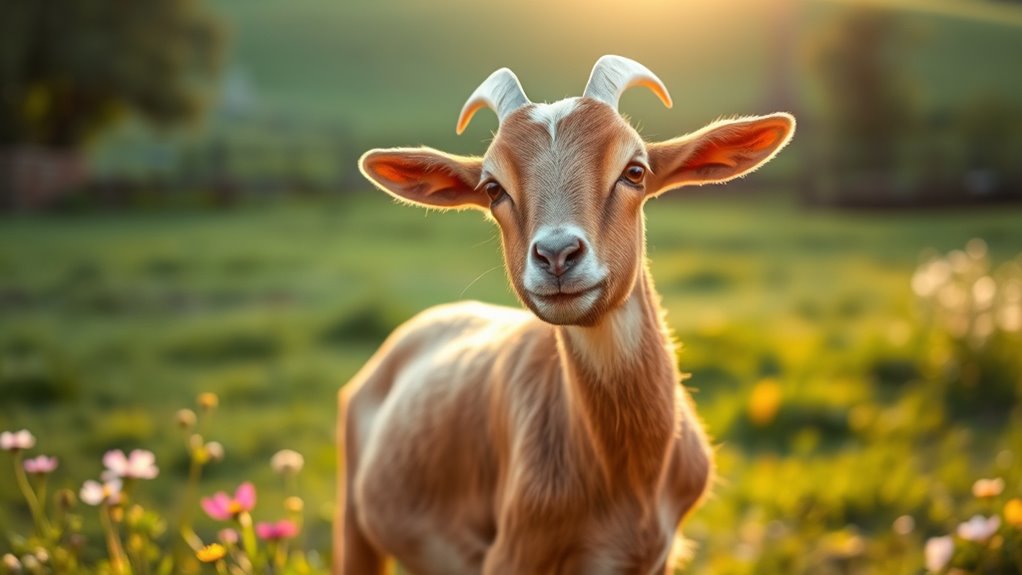
Understanding the estrus cycle changes in your goat is crucial for determining her pregnancy status. The average cycle lasts about 21 days, but it can vary between 18 and 24 days.
Estrus, or heat, typically lasts around 36 hours, with ovulation occurring near the end. If your goat is pregnant, she'll usually not return to estrus, although some mild signs might appear initially.
Non-pregnant does cycle regularly, providing opportunities for breeding. Factors like breed, age, and nutrition can influence her estrous cycle.
Observe her behavior—if she shows no signs of heat, she may be pregnant. Environmental aspects also play a role, so keep an eye on seasonal changes that affect her reproductive cycle.
Recognizing Nesting Behavior

When your goat begins to exhibit nesting behavior, it's a clear sign that she may be preparing for birth.
You might notice her gathering bedding materials, moving objects around with her nose, and seeking a quiet, safe space for delivery. Increased restlessness and pacing are common, along with a tendency to withdraw from the herd.
Your goat may also arrange her bedding to create a comfortable nest, demonstrating her instinct to prepare for the arrival of her kids.
Pay attention to these behaviors, as they indicate her readiness to give birth. Observing these signs can help you ensure she's the right environment for a safe and successful delivery.
Monitoring for Labor Signs
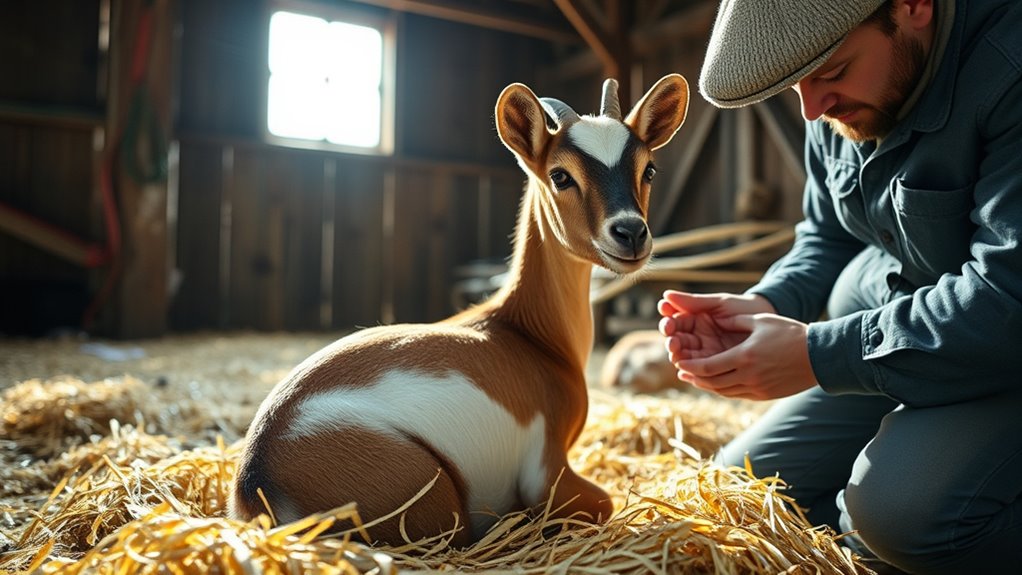
Monitoring for labor signs in your goat is crucial to ensure a smooth birthing process.
Watch for physical changes like udder formation, where it fills with milk and becomes stiff. Teats will lengthen and swell, and you'll notice the doe's belly sagging as the kids position themselves.
Pay attention to her behavior; restlessness, increased vocalization, and separation from the herd are common. Look for a thick mucus discharge, indicating labor is near.
As labor progresses, you may see contractions, heavy breathing, and changes in posture. These signs show the birthing process is underway.
Being attentive to these cues will help you prepare and support your doe during this critical time.
Assessing Appetite Changes
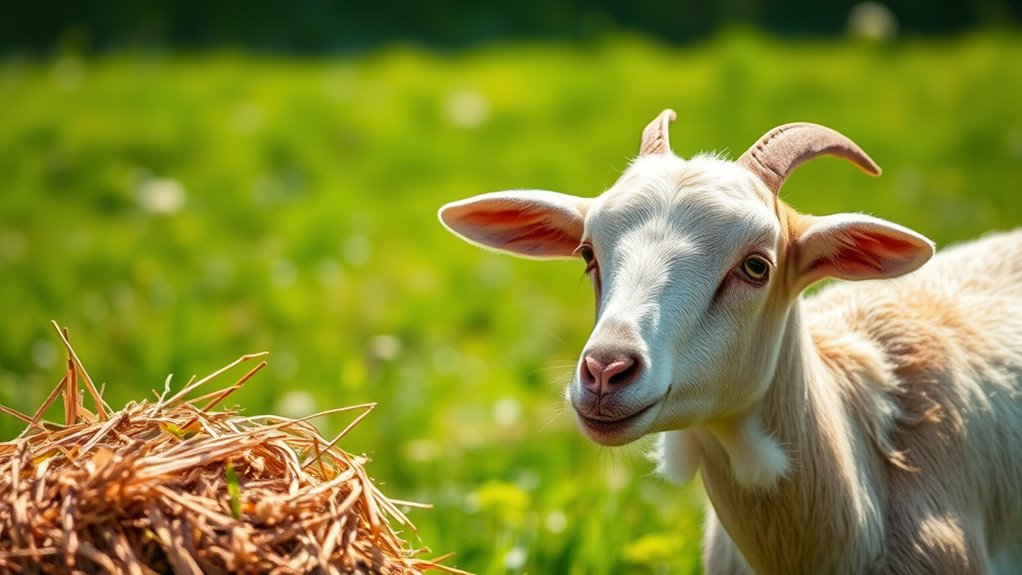
How can you tell if your goat's appetite is changing during pregnancy? You might notice an increased appetite, especially in the later stages, as your goat's nutritional needs rise for fetal growth.
However, be aware that some pregnant goats may display variable eating patterns due to stress or discomfort. In milking does, appetite changes can impact milk production, as their bodies prioritize the developing kids.
Keep an eye out for signs of pregnancy toxemia, too; poor appetite and lethargy can indicate this serious condition, especially in does carrying multiple fetuses.
Monitoring your goat's eating habits closely will help you catch any potential issues early and ensure she stays healthy throughout her pregnancy.
Evaluating Weight Gain
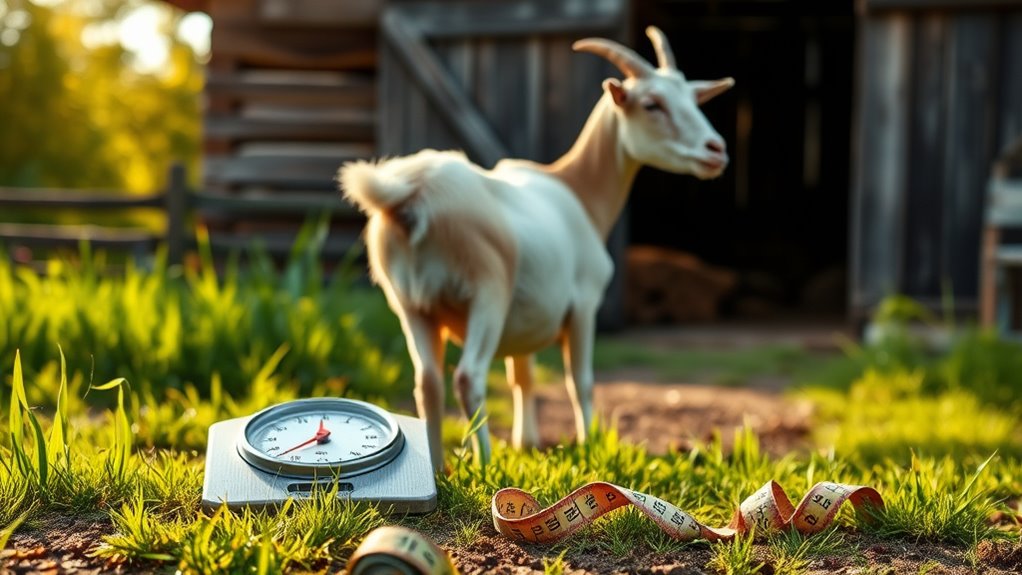
Weight gain is a key sign of pregnancy in goats, especially noticeable in the final weeks.
Weight gain is a significant indicator of pregnancy in goats, particularly evident as they approach their due date.
You'll want to observe the doe's barrel; it swells as the pregnancy progresses. Regularly measuring her girth can provide a clear picture of weight gain.
Also, keep an eye on her body condition score to ensure weight gain is due to pregnancy and not other factors. Increased energy intake is vital during this time to support fetal growth.
As her abdomen enlarges and you notice changes in her overall body shape, it's likely she's pregnant.
These indicators, combined with careful observation, will help you assess her condition accurately and ensure she receives the care she needs during this critical time.
The Importance of Regular Checks
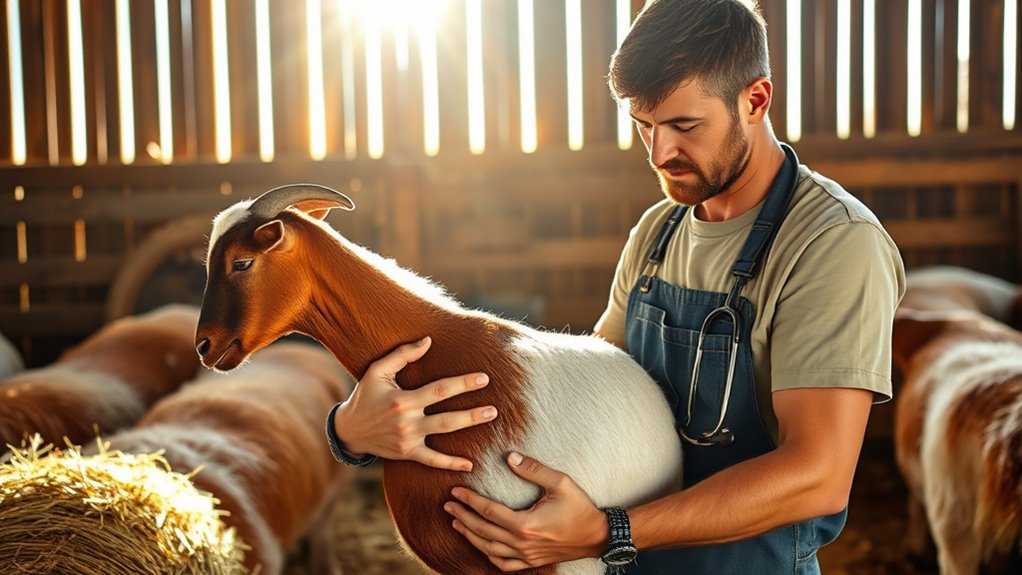
Regular checks are vital for ensuring the health and productivity of your goat herd. Early detection of pregnancy allows you to manage herd health effectively and improve reproductive efficiency.
By identifying non-pregnant animals early, you can rebreed them, boosting overall productivity. Regular checks also help monitor health issues like hydrometra, which can mimic pregnancy. Knowing the pregnancy status of your does aids in planning their nutritional needs, ensuring they receive the right support.
Additionally, these checks evaluate the success of your breeding programs, allowing you to make informed decisions. Incorporating methods like ultrasonography or blood tests can enhance your detection efforts, ensuring your herd remains healthy and productive.
Frequently Asked Questions
Can Goats Experience False Pregnancies, and How Can I Identify Them?
Yes, goats can experience false pregnancies, also known as pseudopregnancies.
To identify them, look for signs like abdominal distension and udder enlargement without a fetus. You won't see typical pregnancy behaviors, and your goat may not show signs of labor.
For a definitive diagnosis, consider using ultrasonography or hormone tests. If you suspect a false pregnancy, consult your veterinarian for appropriate management and treatment options.
What Is the Best Time to Confirm Pregnancy in Goats?
The best time to confirm your goat's pregnancy is after 45 days using transabdominal ultrasound for the most accurate results.
If you're considering blood tests, wait at least 25-30 days post-breeding for the Pregnancy-Specific Protein B test.
For the Estrone Sulfate test, aim for 50-60 days of gestation.
Each method has its timing; so choose the one that fits your situation and provides the clarity you need.
How Does Stress Affect a Goat's Pregnancy Status?
Have you ever wondered how stress can impact your goat's pregnancy?
Stress during pregnancy can lead to behavioral changes in your kids, affecting their emotional reactivity. For instance, high stocking densities may cause increased fear responses, particularly in females.
Maternal stress can also alter fetal development through hormonal changes, potentially leading to long-term consequences.
Ensuring a calm environment is crucial for the well-being of both the pregnant doe and her future offspring.
Are There Any Dietary Changes Needed for Pregnant Goats?
Absolutely, you'll need to make dietary changes for pregnant goats.
Start by increasing their grain intake to about 0.5 to 1 lb daily, especially as they approach the last weeks of gestation.
Ensure they've access to high-quality forage and consider adding protein supplements after day 130.
Don't forget about mineral supplementation, particularly with trace nutrients to support their health and the growing kids.
Always introduce dietary changes gradually to avoid digestive issues.
Can a Goat Get Pregnant While Still Nursing?
A goat can get pregnant while still nursing, like a flower blooming before its seeds have fully sprouted.
It's not ideal, though, as nursing goats need extra energy, and a new pregnancy can strain their health.
You'll want to monitor her nutrition closely, ensuring she gets enough nutrients to support both her and the developing kids.
Managing her diet properly helps prevent health issues, especially during late gestation when energy demands increase.
Conclusion
In the grand adventure of goat parenthood, knowing if your goat's expecting can feel like deciphering hieroglyphics. But fear not! With a sprinkle of diligence and a dash of humor, you can master the art of goat gestation detection. So, keep an eye out for those little signs, and remember: while you might not be hosting a goat-themed baby shower, you could at least be prepared for a surprise delivery! After all, even goats deserve their moment in the spotlight!

